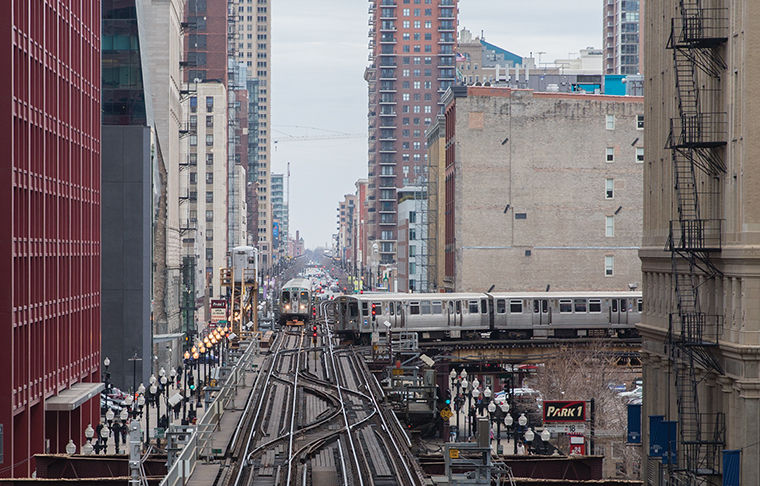CTA campaign raises data, enforcement questions
The CTA answers some raised questions from the October’s anti-harassment campaign.
November 2, 2015
The Chicago Transit Authority’s new anti-harassment campaign was unveiled Oct. 9 with much fanfare but few explicit details on how its new complaint system would work and whether it would prompt riders to confront harassers, putting them at risk of physical harm.
Entitled “If It’s Unwanted, It’s Harassment,” the campaign takes a no-tolerance stance toward abusive behavior, encouraging victims, as well as witnesses, to report any such incidents, as reported Oct. 19 by The Chronicle.
“We don’t say you don’t have to take the harassment. We want people to speak up and report these incidents,” said Catherine Hosinski, a CTA spokeswoman. “[To define verbal harassment] we’re saying if it makes you uncomfortable, report it.”
The campaign was originally launched in 2009 under the name “See Something, Say Something” and was designed in-house by CTA employees. Since then, the CTA has expanded the campaign and alerted the Chicago Police Department so it could anticipate an uptick in reported incidents by passengers, Hosinski said.
The updated campaign allows riders to file complaints on the CTA’s website. Hosinski said information collected from complaints will be forwarded to the CTA’s security department, which works with the police to assess the reports. The department will flag complaints involving severe offenses and analyze information on reported crimes or harassment that will lead to further investigation.
“It may not be criminal, but if it makes you uncomfortable, report it so we can look into it,” Hosinski said. “While that person may not have committed a crime against you, if we start seeing a pattern involving a person matching this description, we can start looking at surveillance and see if that person has committed this act elsewhere.”
Hosinski said that in one recent case, a man was rubbing up against women on crowded CTA vehicles and the incident was reported to local media. After someone called in a similar occurrence in the same time frame, the coverage led to the man being identified.
Hosinski also said the CTA’s head of security James Keating formerly worked for the CPD and provided perspective to help develop the anti-harassment campaign.
In an Oct. 9 press release about the campaign, Keating mentioned the importance of CPD and the CTA working together.
“The CTA, working closely with Chicago Police Department and other law enforcement agencies, has vigorously combated harassment on trains and buses for years,” Keating said.“The public is a critical partner in battling harassment: Reporting incidents is extremely important in increasing safety and helping us to stop offenders from harassing customers.”
“Input from various resources was brought in to the campaign because we wanted to be as thorough as we could,” Hosinski said.
As reported Oct. 19 by The Chronicle, Hosinski said CTA employees will receive training about how to handle certain
situations when riders feel they are harassed on trains and buses. The goal of this training is to assist passengers reporting harassment by calling the police or seeking medical attention after the reported incident.
Ed Yohnka, director of Communications and Public Policy at the American Civil Liberties Union, said he thinks the CTA’s definition of harassment differs from the ACLU’s definition used in legal contexts.
“It’s an important distinction this is not being enforced through any kind of criminal charge, but just with the intervention of someone who is from the CTA,” Yohnka said. “Touching, leering or [making] rude comments are things that would not necessarily lead to a charge of harassment, but in this instance, there is no criminal risk or charge involved [in the harassment].”
Yohnka said harassment on CTA property can be handled in a similar manner to the way it is addressed with other transportation systems, like on airplanes. Flight attendants are also trained to handle issues that might arise among passengers.
“I think there are ways to make this system workable,” Yohnka said. “It’s incumbent upon the CTA to provide that training [for employees]. It’s going to be important to monitor how this [the campaign]actually gets implemented.”
Many CTA riders experience harassment from people who are mentally ill or homeless, and though the harassment may not always be physical, riders are still uncomfortable, Hosinski said. She added it is important to report such instances so CTA personnel and security patrol can help identify persons who may be in need of social services.
“These are folks that may be taking up multiple seats, sleeping on them or continually riding,” Hosinski said. “But we continue to be proactive to provide homeless individuals other options than traveling on our system. By working in teams with trained experts from cultural agencies, we’re able to actively engage the homeless or those who have mental illnesses to take advantage of the shelters or other helpful services.”
If CTA passengers experience harassment to the extent of not knowing what to do, Jennifer Kim, self-defense instructor at The Peace School, 3121 N. Lincoln Ave., advised riders not to engage with harassers, denying them attention can make them “run out of steam and go elsewhere.” By doing this, she said it will be more likely the harassment will not continue and the riders can feel more comfortable while commuting.
“I don’t think you should do anything to antagonize the person,” Kim said. “We need to stay calm, even though it’s hard to do, then breathe and get our own sense of self. It’s really important that when we ride transportation and there’s not a lot of people around, it’s important that we go somewhere where there are people, even if it’s by the conductor.”
To report an incident of harassment on CTA property, visit: http://www.TransitChicago.com/SpeakUp/.








